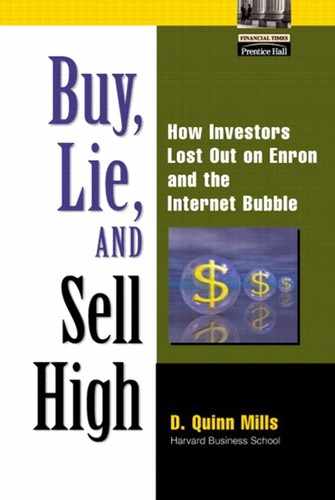How the Financial Value Chain Should Have Worked
The way the Financial Value Chain operated during the bubble is not the way it is supposed to have operated, nor the way we expect it to operate day after day, month after month, year after year. The proper operation of the Financial Value Chain is as follows:
Venture capitalists, who typically demand a very high return on investment because the risk of failure is very high, do their best to ensure that the companies they've backed will have good management teams and a sustainable business model that will stand the test of time. Otherwise, the capital markets should put a relatively low value, consistent with their uncertain future stream of earnings, on venture-backed companies when they are offered for sale to the public. Likewise, investment bankers take public only companies with sound strategies and business models that provide the likelihood of giving investors a decent return.
On the other side of the process, portfolio managers, acting on behalf of investors, try to buy companies that are fairly priced in line with their economic value, and sell companies if they become overvalued, since buying or holding an overvalued stock will inevitably result in a loss. The job of the sell-side analysts—who work for investment banks and brokerage houses—is to objectively monitor the performance of public companies and determine whether or not their stocks are good or bad investments at any point in time, and recommend to investors to buy or sell those companies accordingly. This is what sell-side analysts are supposed to be doing. Accountants carefully audit the financial statements of companies, ensuring that they comply with established standards and represent the true situation of the firms' finances. This is what accountants should be doing because it gives investors and analysts the confidence to make decisions based on financial documents.
As we said before, this is how the system is supposed to work. But during the bubble, the system became quite dysfunctional.
What happened is that venture capitalists and investment bankers were not long in realizing that the Internet might provide the key to a whole new Gold Rush. They were quickly joined by entrepreneurs. Before long, the capital markets were spewing out new issues of stock for an increasingly excited market of investors.
The Financial Value Chain should have worked by having the investment banks make reasonably accurate projections of the future earnings of firms, and from those projections, deriving the net present economic value of firms—which is the basis for financial value. But how could it be done with a new technology involved?
The answer was that analysts made wildly optimistic projections of future earnings. In retrospect, rather than jumping to a conclusion that new firms would be wildly successful, analysts needed to do just the opposite. They had several ways to do this.
First, by being conservative in assumptions: It is common knowledge among analysts that every business plan presented to a venture capitalist, and every set of pro forma financials presented by a firm to its investment bank as the basis for raising capital, has an alternative set of sales and earnings estimates. Some are described as conservative, others as more likely, and still others as hopeful. The estimates which are conservative are generally exaggerated, and those which are more aggressive are said to be more likely than the conservative ones. An analyst quickly learns to expect this and to deflate the forecasts by applying more reasonable assumptions about the future. During the Internet boom, analysts accepted sales and earnings estimates, and conveyed them to the public, that were strikingly exaggerated.
Second, analysts, and the banks for which they work, could have generated more accurate estimates of future sales and earnings by giving a company enough time before taking it public for its income stream to become reasonably well defined. This was one of the reasons for what we shall see was a long-standing rule of thumb among the banks—which went by the wayside during the bubble—that a company shouldn't be offered to the public before having experienced a certain number of quarters of profitability.
